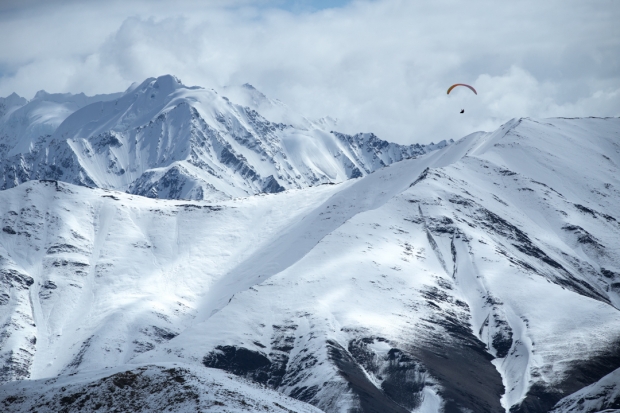
Taking off on the edge of Denali National Park, heading toward Foraker- Photo Jody MacDonald
We knew it would be hard. In fact we anticipated it would be exceedingly brutal. But the reality of the Alaska Traverse is that if we’d actually known how hard Alaska would kick our butts I’m pretty sure neither of us would have gotten out of that plane at Lake Clark, the start of the Alaska range on the west end. We had days where we made less than two miles, going as hard as we could for 16 hours. Weather pinned us down in our tents for 8 days at one go, 5 days at another, 4 days at another…You don’t understand what alder bashing really means until you have to crawl through those heinous fuckers with a heavy pack for five hours trying to get to a launch, every miserable little branch tearing your cloths and skin. Rivers WAY too deep and dangerous to cross, glaciers that were a literal ice maze that would take an entire day to cross, complete with 200 foot wormholes and thunderous falls and crevasses with unknown bottoms. Postholing with frozen feet for two days straight and finding ourselves ecstatic to walk in a glacial river instead for 3 hours (which gave me a pretty nasty case of trench foot) were just some of the obstacles. Dave and I both competed in the X-Alps last year and we both agreed- the “toughest adventure race on Earth” was a holiday compared to Alaska!

Muldrow Glacier, Denali National Park
But this post isn’t about the expedition, which to be honest I don’t yet have my head around. The basics go like this: It took 37 days to complete the traverse. Dave had to leave at day 32 due to other commitments after we’d made it through Denali National Park, which was about 60% of the route. After he left I was pinned down for 4 days in a snow and rain storm, and then the weather, which had been terrible for a month finally came around and I completed the rest of the route mostly in the air in 4 days, eventually flying over 70% of the line. In total, nearly 750 kilometers from one extreme end of the Alaskan range to the other. It was a glorious success, a dream I’d been planning for six years and something I didn’t even really know was possible until I got to the end. The flying was at times wondrous, at times terrifying, but the whole thing was mind-blowing. The SIZE of Alaska and it’s unforgivable terrain are always breathtaking, and at times pretty scary. It was relentless and it was the hardest and yet most rewarding thing I’ve ever done.

Everything you need, nothing you don’t- Photo Jody MacDonald
This post is about our gear. Vol-biv expeditions are a delicate balance between too little and too much. Space and weight. You need to get it just right. For months before we set out I had everything laid out and I’d look at it almost every day, checking my lists over and over again wondering if I had it right. You want to have absolutely everything you need, and nothing you don’t. Dave and I started making repairs at the end of day two and didn’t stop the rest of the way. The terrain tore us, and our gear to pieces. Broken trekking poles, broken wing lines, burned shoes, ripped cloths, broken sunglasses, broken tents. So…here’s what we got right; what we couldn’t have done without; and what we missed, in no particular order.
Of course I can’t comment on every little single piece of gear, so if you want the complete list of what I had in my bivvy kit, here you go. Caveat: I’m sponsored by quite a few of the companies I’ll be discussing here, but I promise- this review is honest and not edited to protect my relationships.
Shelter– they say you can go 30 days without food, 3 days without water, and 3 hours without shelter, so maybe right at the top I’ll talk about our homes. I used the Black Diamond Hilight tent. NOT the Firstlight, which has the much smaller door and is a poor choise if there are two people. The Firstlight is slightly lighter and fine for one person, but I like the side door, I love the space, and with a ground tarp I was easily able to put up make-shift vestibule (rather than carrying the one that you can buy as an extra, which requires another pole and quite a bit more weight). We spent a LOT of time in our tents, and Dave’s Big Bertha, which is smaller and only slightly lighter didn’t have enough space for his pack, and didn’t give him room to sit up, which after a day or two gets really tiring. I love the Hilight. As it’s single wall, you have to treat it well and the sun will kill it on an expedition like this one that takes 37 days, but I used the same one on the Rockies Traverse and so far so good.

Alaska was REALLY tough on gear- photo Jody MacDonald
Safety and communications. We didn’t have cell coverage anywhere in the range except when we crossed the Glen Highway at the end of the Denali park near Cantwell. We discussed carrying Sat phones, but the extra weight and bulk took them out of the equation. The film crew decided on two Iridium phones through my great friends at Satellite Phone Store, who supplied my boat for the last decade with satellite data and the phones worked superbly, even on the north side of the range, which blocks the satellite. I’ve been a huge fan and user of the Delorme InReach for the past few years, but now I don’t think they have a bigger fan. We literally could not have done the expedition without them. If you want a comparison with SPOT and Delorme, go here, I don’t want to get into that with this post. Dave and I as well as the film crew all had units, and we all downloaded the Earthmate maps of Alaska before we departed so we’d have them offline. So every time you send a message, the receiver can simply click on the icon next to the message and see EXACTLY where they are, and how far away they are. So for the film crew to find us on the ground and in the air, the InReaches were critical. Dave and I got separated several times and the same held true for us. When we went for our big flight across Denali National Park the day deteriorated on us early and storms forced us to the ground, but we’d taken very different routes and landed 15 miles from one another. We caught up two days later, using the InReaches to constantly stay in touch which allowed us to keep planning, make decisions, and not just be walking in the dark. The InReach also now has spot weather forecasts, which are very basic, but we also found them very useful as the weather forecasting in Alaska was basically impossible (but HUGE thanks to Stewart Midwinter, Bruce Marks, and Pete Pupator for feeding us everything they could find on the Delorme’s!).

Making plans in the Rohn Cabin, day 17
Wing and Harness. I used the Niviuk Klimber P, their new lightweight three-liner EN D that was developed specifically for hike and fly (not yet available for sale, but will be soon). I fell in love with the wing on the first flight and liked her more and more as the days went by. We flew in some terrifically strong conditions, in fact one flight after Dave left was possibly the strongest I’ve ever experienced. I got blown over two mountains and had a pretty keen eye on my reserve for 20 very exciting (and not in a good way!) kilometers. I’ve yet to have a collapse. Easy to launch in tight spots, an awesome high-performance wing with just the right amount of passive safety to make it a very nice weapon for serious cross country. Those of you who like to geek out on tech, one thing that should be pointed out with Niviuk wings is that they are using the French brand Porcher-Sport for their fabrics, whereas most manufacturers go with much cheaper fabrics sourced in Asia. Which just means the Niviuk wings will hold up much longer to the elements. I used the Sup’Air Delight for my harness with the back/seat pad removed. Incredibly the harness got me all the way through without a scratch. The Delight is remarkably well-thought-out. I love the flight deck, the easy adjustments, it’s incredibly light-weight and I found the space available just enough for all the gear and food, even at the end when I was carrying about 10 days worth (the 3rd food cache was all mine after Dave left, which I happily carried as we radically under-estimated our caloric burn and were well short in the first two food caches). I’d change two things. One was the pocket for your water system (I used the 4 L MSR black Dromedary with the hydration kit rather than a platypus or camelbak or similar as I knew they would fail after one hard bump), which is too small for anything over about 1.5 liters, and I’d add glove/food pockets to the pod on the outside (I hate launching with gloves, and I don’t like putting things in my jacket pocket as they are so hard to retrieve on flight). I’m still using my trusty Advance 100 liter backpack to hold all my gear, which I’ve used for the past 4 years as the backpacks that wing manufacturers give you with the wing, with the exception of Advance remain pathetic and can’t be used other than getting your gear to the car.
Repair kit and Medical/ First Aid Kit. Thankfully neither of our medical kits were used for much other than Advil, but as I’ve got what I think is a pretty refined kit here you go:
Medical: photo canister with dryer lint and purell hand sanitizer for starting fires in an emergency (thanks to Terry O’Connor for this tip!), medical tweezers, gauze, various pain drugs, gloves, lighter, super glue, bandages, steri-strips, syringe (for flushing wounds), first aid tape, benzoine (for preventing blisters, keeping skin dry), sleeping pills (I sleep very poorly). Repair: quite a bit of wing fabric, tenacious tape, blunt nose needle for line repairs, line for every length on the glider, super glue, dental floss (for sewing), marking pen, and a good length of P-cord which you can un-sheath and use the three-brand inside for sewing pretty much anything (a trick I learned from Dave).
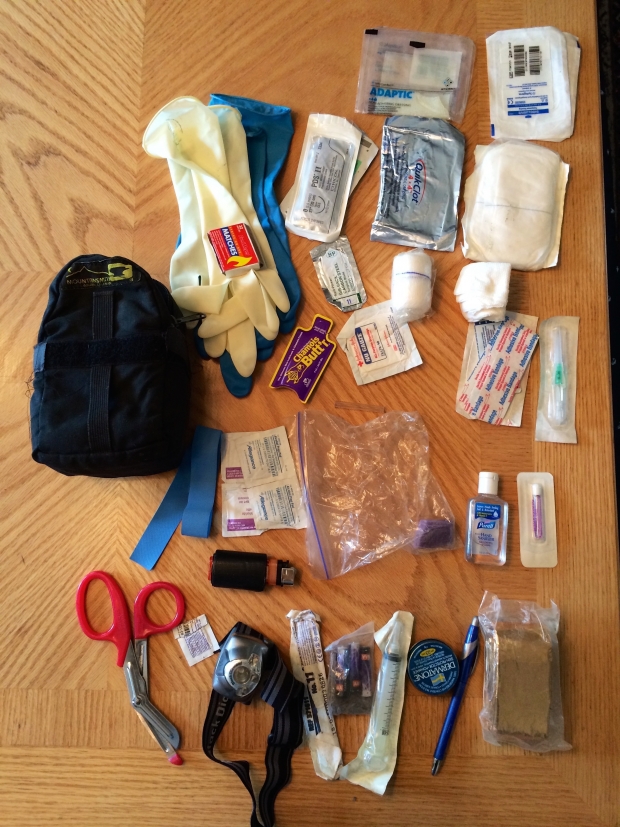
Helmet– Smith Forefront (not EN certified for flying!), which is light and fits well with my Smith Pivlock sunglasses, which I pretty much do EVERYTHING in.
Sleeping bag and sleeping. Ok, this one was critical. I used a zero degree Western Mountaineering down bag. We had a lot of HORRENDOUS, and very cold weather. I use a silk liner because I hate feeling dirty and I prefer to sleep naked (too much information?). Western Mountaineering makes the highest-end (and most expensive!) bags there are, and it is money well spent. For my pad I used the Klymit Intertia X-Lite, which is the lightest and most compact inflatable pad out there. It is MINIMALIST and for those who want more comfort you’ve got to step up to one of their beefier pads, but I find the X-Lite enough. Unfortunately it blew on me about day 20, which was my fault. Like I said- they are minimalist and you’ve got to treat them with care.
Food. As this was an unsupported expedition we put in food caches at predetermined spots along the route in advance. When the movie comes out you’ll all see a lot more clearly than in this blog post how that all went, but in short we fell well short of the calories needed as we underestimated the amount of ground game we’d be playing, especially early on. We planned each cache to have 5-7 days of food, but really we could have eaten everything in the caches in 3 days. We needed a LOT more fat and protein and sugar, and because we didn’t have enough we spent a lot of time pretty much starving. Sausage, cheese and chocolate were needed badly. This would not have been an expedition a leaf-eater could have pulled off in my opinion. It was cold, and it was SUPER physical. Many of the days were 6-8,000 calorie days, which is really hard to replenish. We relied mostly on Patagonia Provisions delicious repertoire of yummies (the favorite being the smoked salmon) and a ton of dehydrated meals, mostly from Mountain House, which I like the best. On past bivvy expeditions I’ve never thought it was possible to carry more than 5 days of food, but we learned on this one, give us two pound blocks of cheese and a stack of cadbury chocolate several pounds of gorp and several pounds of sausage- you’ll figure out a way to make it work!
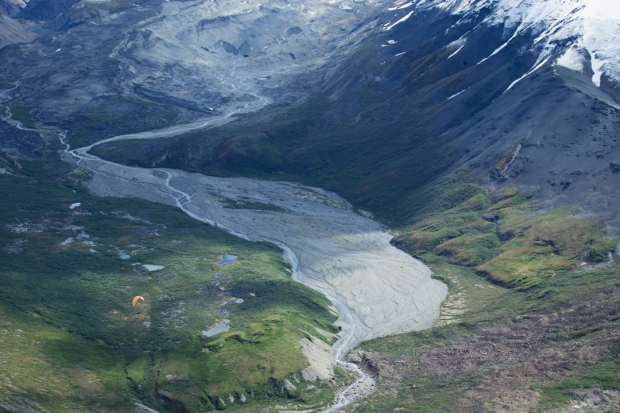
Heading out on the Denali flight, Photo Jody MacDonald
Charging. Due to weight and size, I chose the new GoalZero Nomad 7+ instead of my normal 9 watt Noco panel. My first panel lasted less than 48 hours. So…clearly they are not very robust. But I had another one brought into the field by the film crew (I know, this kind of breaks the “unsupported” rule, but without charging we were dead in the water and for the film, having our Delorme’s and GoPro’s charged up was critical and considered acceptable) and the second one worked great. It never gets dark in June in Alaska so we always had plenty of time to charge our phones (which we used mostly for mapping and the Earthmate app with the InReach devices), varios, and InReaches.
Stove and “kitchen”. This was something Dave and I discussed a lot. In the end I went for the MSR pocketrocket for cooking with fuel, and a light-weight pot kit (aluminum) as for the most part we cooked on fire. We tried to avoid cooking with fuel as much as possible, and this worked in all places except when we were camped high. The big surprise for me was taking an AVEX coffee mug into the field. I’d completed an 8 day ski traverse in Idaho right before the Alaska expedition and felt really silly for taking a cheap Chinese camp mug into the field instead of an insulated cup like everyone else had so decided to upgrade for the Alaska Traverse. Ok, ends up being some extra weight and bulk, but having a HOT cup of coffee every morning and hot cup of tea, that STAYS hot literally longer than you can believe was an upgrade I was more than happy to carry. Aluminum spoon instead of plastic, back up lighter, and a small container of salt and pepper and that was it for the kitchen. We both missed hot sauce.
Instruments and Mapping. Instead of carrying my dedicated Flytec vario I went with my iphone and ran the FlySkyHy app which worked well (although I find their offline map downloads a little challenging so I was using it without maps) paired to the XC Tracer vario, which I am LOVING. I still have to get the audio settings more in-line with how a barometric vario “averages” your climb as I’m struggling a bit with coring thermals, but the XCTracer is really the future of varios. It has zero time lag, weighs a paltry 61 grams, lasts 14 hours on a single charge, logs IGC files, connects instantly via bluetooth to my phone every time without a hitch and is so small I have to be careful not to lose it! Brilliant little device. For mapping we decided on the POWERFUL Gaia GPS pro app, the only topographic mapping app I really trust and my go-to for everything I do in the backcountry (we’re even hopefully going to use this app for the next X-Alps!). Gaia GPS integrates the best topo maps, offline navigation tools, and planning features seamlessly across phones, tablets, and gaiagps.com. I downloaded the maps well in advance of the trip (they are big files so it takes awhile), and this combined with Dave having most of the line cached on his google earth app gave us everything we needed to make navigation choices on the run. It even saved my ass when I dialed up and flew in a cloud for over 20 minutes on the Denali flight. I was blind, covered in rime ice and I used Gaia to make sure I wasn’t going to crash into a mountain! Wait til you see that footage!
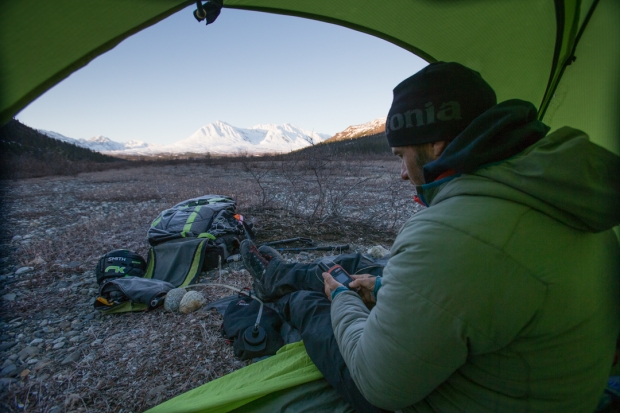
Getting ready to head up to our second launch from the Kuskokwim River on a frosty morning. Photo Jody MacDonald
Footwear. Our shoes had to be tough and waterproof, but also comfortable. I went with the Salewa Firetail Evo Mid GTX. I was a little nervous heading out on day 1 as I hadn’t even had a chance to put them on, let alone break them in, but luckily they fit like a glove and even with my blister-prone feet I went blister free for the full expedition. I don’t think there is a “waterproof” that would have worked on this trip, as we fjorded so many rivers I lost count on day two. So our feet were soaked and a healthy fire every night was needed to dry out our shoes and gear. In retrospect, the Firetail was maybe too soft of a hiking shoe for the rigors of Alaska, and I probably should have gone with their more burly Mountain Trainer GTX, but nothing could have solved the pretty nasty case of trench foot I developed over the course of the expedition. The Firetail is SUPER light (which I think is very important for staying nimble on launches and landings), has an awesome vibram sole, and isn’t too bulky for getting in and out of your pod harness or using the speed bar- important!
Clothing. For a full list click the link at the top of the post, but Dave and I both went with quite a few light Patagonia layers and they were PERFECT. For pants I went with Houdini’s (super light-weight, a great layer for when it was hot but we need leg protection from the alders), running tights (instead of long underwear to save weight), and their lightest rain pant- the Torrentshells. Up topside I went with their merino long sleeve t-shirt (doesn’t get smelly!) instead of cotton, then their awesome R1 Hoody, the Nano-Air hoody, M10 Rain Jacket, and for warmth the Down Sweater (which I pretty much lived in).
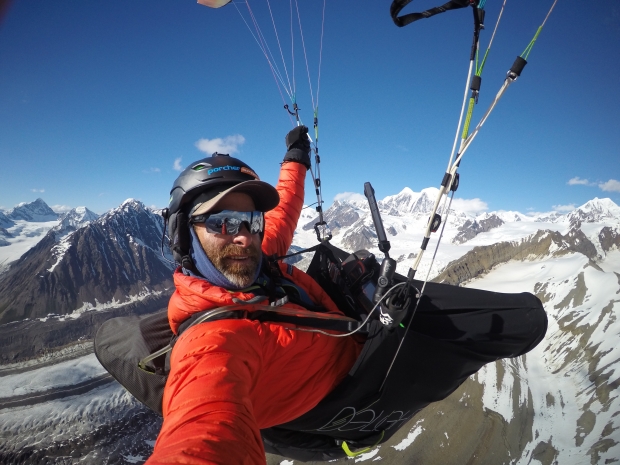
Flying over the Susitna Glacier on the last flight of the expedition
Unexpected Godsend. Packcover. At the last minute I threw in a rain cover for my pack. Brilliant addition, not only for the snow and rain, but for the never-ending alder and bush bashing. Dave’s pack got pretty shredded up as he went for a garbage bag. Ok, and the AVEX coffee cup- god I loved that thing!
What we REALLY could have used. Both Dave and I forgot gators. BIG, MASSIVE, UNFORGIVABLE mistake. For the endless postholing, for forging those beastly glaciers, for walking in all those swamps- gators would have been really nice (we did end up cutting off pieces from our tree kit and fashioning home-made gators out of our ski pants, which helped a lot). The other thing we could have used was a workable water filtration system. As there are animals everywhere, Giardia is a real risk that we were actually pretty worried about. I brought a SteriPen Freedom (which has been replaced with the Adventurer Opti), which for the size and given you can recharge it in the field, is for me better than a pump filter BUT- they don’t work with dromedary-type water canisters (ie they only work with solid “nalgene” type bottles and not bags) and mine broke on day one (my fault), so it was useless. In the end we used a lot of snow which was safe (another reason to go with the black MSR Dromedary as the snow melts fast in the sun), and tried to use water that was high in streams. So far, so good.
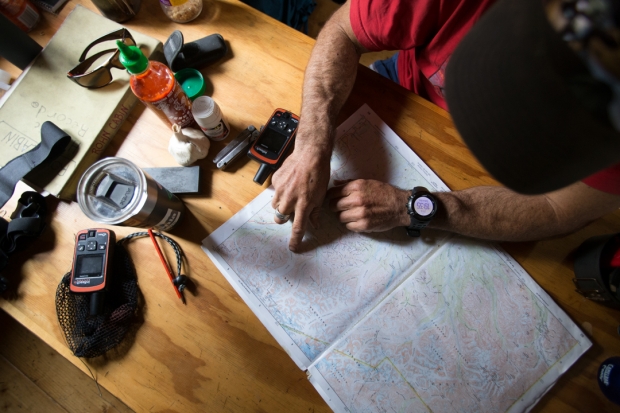
Timepiece. Suunto Ambit Peak 3. I don’t see too many people adventuring in the backcountry without this watch. I keep track of all my movements (workouts, or in this case just trying to make progress)- be it backcountry skiing, training for the X-Alps, mountain biking, paragliding- you name it with this watch.
Other critical items: Sunblock (we used Beyond Coastal, which I’ve used for over a decade and love), bug spray, gloves (light and heavy), leatherman, trekking poles (BD’s carbon trekking poles were what we both used, and both broke, but that was our fault, not the pole), COFFEE, buff, ball cap, eye cover for sleeping (sun never goes down), ear plugs (so you don’t hear the bears at night:), cables for charging, external battery (I went with the 12,000 mAh mophie), condom catheters, ground tarp, spare socks, laundry soap (if going longer than a couple weeks, socks and underwear get to the point of wanting to burn them!), radio, PTT (I use the Thermal Tracker Push to Talk, which is simply the best. If you want to be heard and don’t want to mess with an unreliable and bulky remote mic, go with the Thermal Tracker PTT), chap stick, and a healthy dose of optimism.
Could have done without: headlamp (it never gets dark)! and board shorts (it never really got warm enough to warrant carrying them).
I’d love to hear if this list is useful to any of you and feel free to contact me if you still have questions. And if any of you have any ideas on how I can possibly beat the Alaska Traverse for big and bold, I’m all ears!



Thanks for the great write up. You two are beastly! You know everyone can’t wait to hear your Alaska podcast
Another highly useful read Gavin, thank you ..
As I understand you actually use your iPhone as your flight instrument coupled with the XCtracer.. however do you manage to keep the iPhone itself running in varying and sometimes cold temperatures, is it not prone to fail in the cold? And I am assuming that you keep the powerbank in the cockpit to power the iPhone?
Hey Stian, correct on all. I keep at 12,000 mAh external battery in my flight deck with a cable for iphone and android. I keep my phone plugged in from the start and if needed I can juice my Delorme (which I’ve never needed to do, those batteries last forever) or my XC Tracer (ditto).
Good work gents! What type of sleeping pills? Did you notice any long term effects from those, and do you think that a beefier & more comfortable sleeping pad would have been an acceptable trade in the “weight-for-sleep” category?
Hey Nik,
I just use those over the counter “Sominex” pills when I get desperate. I use the pad and also sleep on my concertina wing, which is enough…but I think next time I’ll go with a beefier pad for sure. It’s enough…but just. I’m just a shit sleeper. Meditation really helps, as does not eating chocolate and coffee late in the day, but I’m only human!
Very useful. Thanks Gavin. No gloves? What reserve did you take with you?
Hey Guy,
I didn’t comment on gloves as this seems so specific to everyone, but I used some heavier BD gloves and a lighter fleece pair as well. I used the Independence Skyman lightweight round reserve, same as the one I used for the X-Alps, but after my reserve tosses when I was acro training this winter, those 100KG light-weights come down awfully fast and for “normal” flying I’m using a Beamer 3 as well as a larger round these days.
Funny to see the “hot sauce” on the table in so many of those cabin photographs :-). Essential stuff! Gavin, you are totally bezerk, thanks for sharing your inspiring stories!!!
Thanks Frederic! Mmmmm….hot sauce!
Just found your blog, and stoked to have found this entry. Really cool to see how you guys put this all together, but here’s a seemingly dumb question:
Did you guys actually pack all this stuff up AND flew with all the gear as well? I’m a novice paraglider, and getting all my wing in my harness/pack is tough as it is! Thanks again.
I’m looking forward to seeing the movie!
Hey Jau,
Yes we did- we put in food caches in advance which didn’t work out so hot (we mostly starved) but we carried all our paragliding and living/camping gear the whole way. Dry (ie without water) both of our packs weighed about 60-65 pounds depending on food load. At the end after Dave left I took all his food and was up close to 80, but I was more than happy to carry the extra weight and eat well!
What Pack did you carry? Live up here in AK and trying to find a nice pack for VOL Biv on Denali Highway.
Thanks!
Hey Nate,
I used the Advance 100 Litre comfortpack. I’ve used this one for all my bivvy trips, back to the Sierra trip in 2012 and a short bivvy I did with Sylvester in Bir in 2011. You can go lighter for sure, but Dave’s Ozone backpack that comes with the Ozium literally fell apart on the trip- so you’ve got to match the gear with the mission:)
If you are starting around Carlo Creek/Cantwell and heading east then the terrain is really friendly, very few alders, etc so you can probably get away with something lighter weight.
Sounds rad, have fun!
Hey Gavin,
I’m interested in working a Thermal Tracker PTT into my comms system. Can you comment on how well the mic integrates with an open face helmet? Does it tend to get in the way or snag on lines and overall how was the wind noise? Thanks in advance.
Hey Brandon,
Sorry for the delay, I was competing in the X-Alps and just finished yesterday. I use the Thermal Tracker PTT w my open face, works great. I put some soft foam over the mic end and just tuck it into my buff so it stays near my mouth. Then I cut a small hole in the helmet ear covers and slide the earpiece into the hole. You can also put a small screw into your helmet to hold the wire, but I don’t find it needs it as the earpiece and transmitter button, which you just velcro to the side of the helmet keeps it all in place. Kevin sends a ton of extra stuff like velcro and spare parts with the PTT system.
Have fun!
Great documentary!! I felt I was in the air with you. I just started using an external catheter (with foam wrap) in Refugio, TX for our hang gliding xc encampment two weeks ago. It worked good except it slipped off on a couple flights. What type are you using?
Bun
I just use surgical hose and I use the sticky condoms sold through these guys: http://www.totalhomecaresupplies.com/ProductDetail.aspx?Name=Coloplast_Freedom_Clear_LS_Male_External_Catheter&CategoryName=NR_5490
Choose a size smaller than you are because in flight you get cold and “small”:)
Have fun!
Hey Gavin, would you mind sharing the XCTracer settings that you ended up liking the most? I just got an XCT mini II, and I’m also used to Flytec varios.
Of course! Shoot me an email and I’ll send it over: gavin at cloudbasemayhem.com
Thanks! Just sent you an email.
Thanks so much for sharing such an amazing adventure and and all the detail above. Clearly this was pushing the limits and you needed more gear than many vol biv setups. I would love to carry a similar setup but worry about the weight. I read about others managing without some of the bigger items like sleeping bags (in warmer climates). Do you know much your gear weighed in total?
Hey Andrew I hope I replied to you? Just doing some website housecleaning and saw your message. Gear in Alaska was about 55 pounds without water, got close to 75 when I had full food (5-7 days) onboard and water. Heavy!!